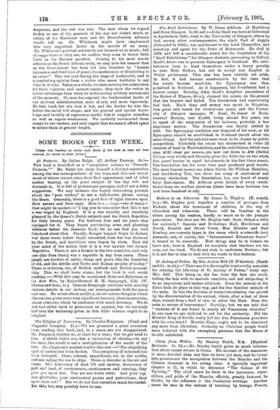The Snell Exhibitions. By W. Lanes Addison. (J. Maclehose and
Sons, Glasgow. 7s.6d.net.)—John Snell was born at Colmonell in Ayrshire in 1629 ; went to the University of Glasgow, where he had, among other contemporaries, the ninth Earl of Argyle (beheaded in 1685); was seal-bearer to the Lord Chancellor, and secretary and agent for the Duke of Monmouth. He died in 1679, and left a considerable estate for the foundation of the " Snell Exhibitions " for Glasgow students proceeding to Oxford. Snell's desire was to promote Episcopacy in Scotland. His exhi- bitioners were to bind themselves under a heavy penalty to take Holy Orders, but not to accept any English or Welsh preferment. This aim has been entirely set aside, In fact, it had become unattainable by the time that the estate became available, for Episcopacy was then penalised in Scotland. As it happened, the foundation bad a narrow escape. Dorothy, John Snell's daughter (ancestress of the Guises of Elmore, Glos.), claimed the estate, on the ground that the bequest had failed. The foundation had consistently bad luck. Much time and money was spent in litigation. One great suit lasted for twenty-one years, and the Univer- sity of Glasgow manager, W. Ruat, Professor of Eccle- siastical History, cost £1,000, being absent five years, not to speak of the suspension of his lectures, probably a less important matter. The foundation was finally settled in 1861. The Episcopacy condition was disposed of for ever, or till Episcopacy should be established in Scotland (much about the same thing). And the exhibitioners were to be chosen by public competition. Unluckily the estate has diminished in value (it consists of land in Warwickshire), and the exhibitions, which were once £120 clear per annum, are now cut down to £80 (Balliol College very wisely and liberally gives the £400 due on the whole five years' tenure in equal instalments in the first three years). The foundation has for some time past produced good results. The most famous names are Adam Smith. Sir William Hamilton, and Archbishop Tait, but there are many of academical and literary distinction. The foundation, too, can boast of nearly forty ,first-classes. Mr. Addison gives details of every exhibi- tioner from the earliest elections (there have been between two and three hundred in all).


































 Previous page
Previous page